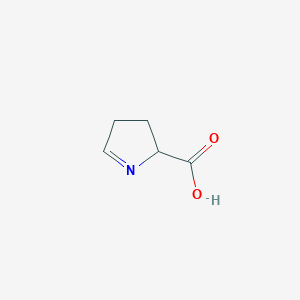| General Information of MET (ID: META00404) |
| Name |
1-Pyrroline-5-carboxylic acid
|
| Synonyms |
Click to Show/Hide Synonyms of This Metabolite
(S)-1-Pyrroline-5-carboxylate; 1-Pyrroline-5-carboxylate; 3,4-Dihydro-2H-pyrrole-2-carboxylate; 3,4-Dihydro-2H-pyrrole-2-carboxylic acid; D1-Pyrroline-5-carboxylate; D1-Pyrroline-5-carboxylic acid; DL-1-Pyrroline-5-carboxylate; DL-1-Pyrroline-5-carboxylic acid; Delta(1)-Pyrroline-5-carboxylic acid; L-1-Pyrroline-5-carboxylate; L-delta 1-Pyrroline-5-carboxylate; Pyrroline 5-carboxylate; Pyrroline-5-carboxylate; delta(1)Pyrroline-5-carboxylate; delta-1-Pyrroline-5-carboxylate; delta-1-Pyrroline-5-carboxylate, (+-)-isomer; delta-1-Pyrroline-5-carboxylate, 14C-labeled, (+-)-isomer; delta-1-Pyrroline-5-carboxylic acid
|
| Source |
Endogenous;Escherichia Coli Metabolite;Yeast Metabolite;Food;Toxins/Pollutant;Microbial
|
| Structure Type |
Amino acids, peptides, and analogues (Click to Show/Hide the Complete Structure Type Hierarchy)
Organic acids and derivatives
Carboxylic acids and derivatives
Amino acids, peptides, and analogues
|
| PubChem CID |
|
| HMDB ID |
|
| Formula |
C5H7NO2
|
| Structure |
<iframe style="width: 300px; height: 300px;" frameborder="0" src="https://embed.molview.org/v1/?mode=balls&cid=1196"></iframe>
|
 |
|
3D MOL
|
2D MOL
|
|
Click to Show/Hide the Molecular/Functional Data (External Links/Property/Function) of This Metabolite
|
| KEGG ID |
|
| ChEBI ID |
|
| FooDB ID |
|
| ChemSpider ID |
|
| METLIN ID |
|
| Physicochemical Properties |
Molecular Weight |
113.11 |
Topological Polar Surface Area |
49.7 |
| XlogP |
-0.5 |
Complexity |
130 |
| Heavy Atom Count |
8 |
Rotatable Bond Count |
1 |
| Hydrogen Bond Donor Count |
1 |
Hydrogen Bond Acceptor Count |
3 |
| Function |
1-Pyrroline-5-carboxylic acid is an enamine or an imino acid that forms upon the spontaneous dehydration of L-glutamate gamma-semialdehyde in aqueous solutions. The stereoisomer (S)-1-pyrroline-5-carboxylate is an intermediate in glutamate metabolism, arginine degradation, and proline biosynthesis and degradation. It can also be converted into or be formed from three amino acids: L-glutamate, L-ornithine, and L-proline. In particular, it is synthesized via the oxidation of proline by pyrroline-5-carboxylate reductase 1 (PYCR1) (EC 1.5.1.2) or by proline dehydrogenase (PRODH) (EC 1.5.99.8). It is hydrolyzed to L-glutamate by delta-1-pyrroline-5-carboxylate dehydrogenase (ALDH4A1) (EC 1.5.1.12). It is also one of the few metabolites that can act as a precursor to other metabolites of both the urea cycle and the tricarboxylic acid (TCA) cycle. Under certain conditions, pyrroline-5-carboxylate can act as a neurotoxin and a metabotoxin. A neurotoxin causes damage to nerve cells and nerve tissues. A metabotoxin is an endogenously produced metabolite that causes adverse health effects at chronically high levels. Chronically high levels of pyrroline-5-carboxylate are associated with at least five inborn errors of metabolism, including hyperprolinemia type I, hyperprolinemia type II, iminoglycinuria, prolinemia type II, and pyruvate carboxylase deficiency. Hyperprolinemia type II results in high levels of pyrroline-5-carboxylate. People with hyperprolinemia type II have signs and symptoms that vary in severity, but they are more likely than type I to have seizures or intellectual disability. Pyrroline-5-carboxylate is highly reactive and excess quantities have been shown to cause cell death and apoptosis.
|
|
Regulatory Network
|
|
|
|
|
|
|
|
|
 click to show the details of this protein
click to show the details of this protein
 click to show the details of experiment for validating this pair
click to show the details of experiment for validating this pair

